Ellen and Jim Have a Blog, Too
We are two part-time academics. Ellen teaches in the English department and Jim in the IT program at George Mason University.


Filmic women: mirrors, windows, & candles · 6 August 08
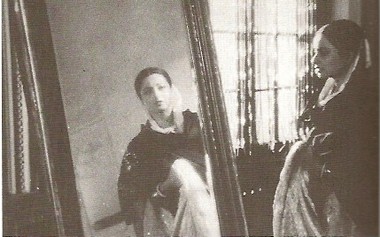
Identity as self-alienation, Umrao Jan, Indian courtesan film
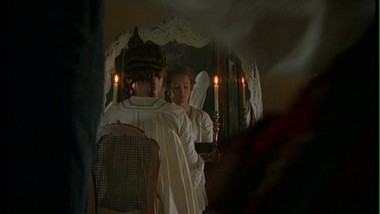
Taken at random from 1999 Aristocrats: Caroline Lennox Fox (Serena Gordon) seen through the mirror and her husband, Henry Fox (Alun Armstrong) as he undresses
Dear Friends,
I’ve read another book straight through with great enjoyment: Sumitra Chakravarty’s National Identity in Popular Indian Cinema highly enough; if possible, it’s better than Vijay Michra’s Bollywood Cinema: Temples of Desire (outlined briefly as a comment Sunday night). Like Michra’s, Chakravarty’s book is written in a way that has general application and can shed light on all movies you read: she really is about more than popular cinema because she considers most “art” movies to be commercial products and sees them as negotiating between different audiences, and takes into acount how many intelligent viewers go to movies to experience a Utopian or pleasurable illusion so that for such a person what he or she expects in a lecture or serious book is quite different from what they want in a movie (the discouse here justifies what we see in quality mini-series for example).
I’ll take just one instance at length: Chakravarty actually discusses the persistent way heroines in movies are filmed through the mirror (pp. 271ff). (This happened in the new Brideshead Revisited several times, even down to showing us women’s faces in the side-mirror of an automobile.) Instead of the camera focusing directly on the actress’s face, it focuses on the mirror and we look with her into the mirror. This is so persistent that when a movie does pass the first part of the Bechdel test (i.e., we have two heroines talking together) we see the both of them in a mirror.
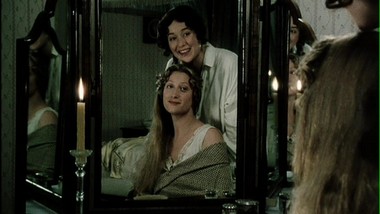
Jane (Samantha Harker) and Elizabeth (Jennifer Ehle) in ‘95 P&P (whole scene conducted through mirrors)
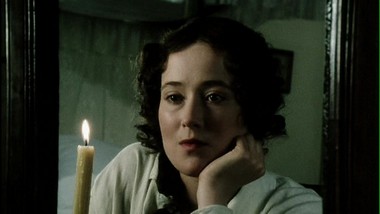
We see her in the mirror
By contrast, rarely is the man seen through the mirror (also rarely is he seen looking out a window sitting there).
As the Austen movies often pass the Bechdel test, so some rare instances are found in these. IN the 1981 S&S there’s an uncommon presentation of a male or hero: we at first see Bosco Hogan as Edward looking at himself in the mirror (very twisted expression on his face) just before Irene Richards as Elinor tells him Brandon is offering him a living that he cannot not want (an offer he can’t refuse) as it will make him independent even if he finds himself punished with it by being driven to marry Lucy Steele.
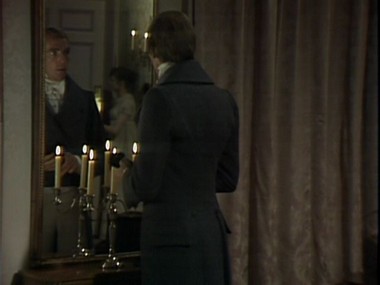
Edward (Bosco Hogan) facing mirror with candles to the side (‘81 S&S)
It’s only brief and he turns back to look at her and we look directly at him through her eyes, and we feel his self-scorn as he sees himself through her compassionate eyes. It is highly uncommon for males to be presented this way. And on top of this the scene has a burning candle next to him in the dusk—another motif shown with women.
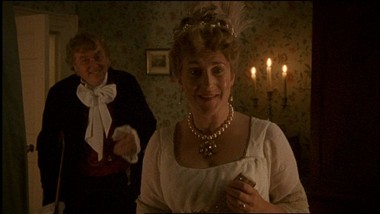
Taken at random from comic moment: Mrs Allen (Sylvestre Le Tousel) watches Catherine (Felicity Jones) at her mirror (‘07 NA)
Also rarely do we see a man looking out a window (when this is a ubiquitous image for women). An instance of this occurs more than once in the ‘95 P&P: Colin Firth may be seen almost regularly standing at a window looking out, brooding:
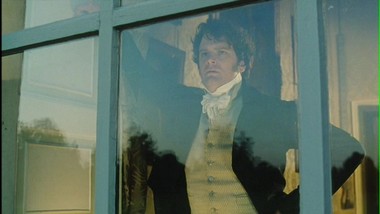
Darcy (Colin Firth) at window (‘95 P&P)
This has been noticed more than once and it is even “justified” in the Making of P&P book (as if an embarrassment). But in Austen’s P&P Darcy it turns out is sensitive, shy as well as proud and even unsure of himself with others, not easily able to integrate into a group as he tells Elizabeth when she plays the piano before him at Rosings.
I’ve asked myself why this is? Why do we usually persistently see women through mirrors, even two of them. Chakravarty first quotes Virginia Woolf: “women have served all these centuries as looking-glasses possessing the magic and delicious power of reflecting the figure of man at twice his natural size.” In these movies the camera focuses on the male heroes the woman wants and we see them as desirable through her eyes. She herself is the mirror. But what of the mirror presented before her. Well according to Chakravarty she is looking at herself as society sees her; preparing and shaping herself to be observed by others; it shows the alienation of women from herself, and how she is driven to be a creature shaped by the community’s eyes. I don’t know if this persuades others, but it is an explanation of something hardly ever (=never in Mansfield Park) brought
up. The woman is on a quest to find her identity and when she looks she sees a hollow image reflected back of what society has made her.
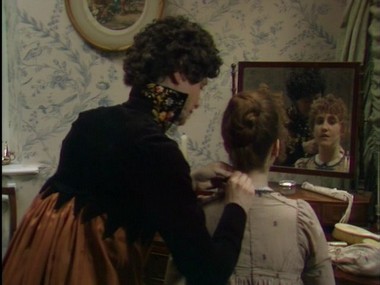
Fanny (Sylvestre Le Tousel) looking at herself in mirror with necklace (Henry’s, unknown to her), Mary (Jackie Wood-Smith), encouraging (‘83 MP)
Again, in Austen’s S&S Edward Ferrars has been disinherited. He is an emasculated male—as is John Willoughby in this curious novel and also Brandon was when young and a second son and helpless to rescue his cousin-sister from marriage to his horror of an older brother and father as her guardian. I noticed in S&S films repeatedly we have Willoughby facing himself near a mirror as he stands looking away from the Dashwood women into a fireplace before he turns to talk.
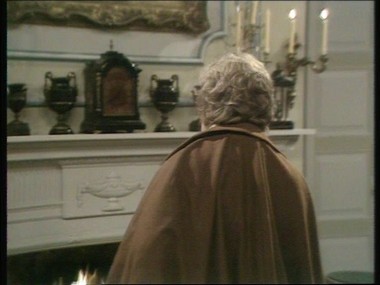
Willoughby (Clive Francis) facing fireplace (‘71 S&S)
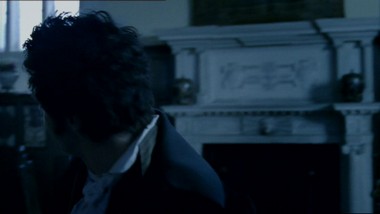
Willoughby (Dominic Cooper), here an angry thug, still turns back (‘08 S&S)
More briefly, Chakravarty describes what’s called “realism” in movies as “a heightened emotionalism, the call to an empathic identification with the underprivileged” (p. 81). The country becomes a “privatized fictional space” where characters can recover from modern society (p. 103); there can be a return to the past, to a “mother” or home country, where the urban place is where characters confront pain, temptation, joblessness, anonymity, worldliness. Acts of renunciation function as moral codes of rejection (p. 105-6). Women’s social and even individual identities are conferred by marriage (p. 117). The way in which powerful politics are presented is throgh showing conflicts between family and private identity and what is demanded by public roles; so too corruption in business is revealed through these conflicts (p. 143). This reminded me of the BBC 1974 Pallisers.
Historical films, costume dramas emerge as a relatively elite form (p. 157). Popular audiences go for here and now, today, partly because representing history usually means political commentary, meditation on national identity and real crises in the here and now mirrored through famous events or romantic periods and landscapes (pp. 157-59). It is a dwelling on public memories, and a means of resolving tensions over problems today. (Longitude is about class and politics today even if set in the 18th century and early 20th.)
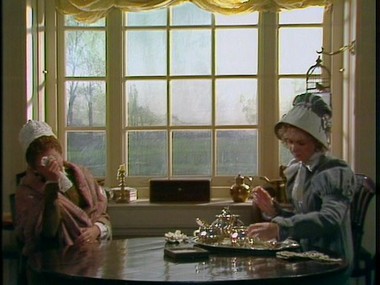
Even in comedy the window (and here bird in a cage) dominates: Mrs Bennet (Priscilla Morgan) and her sister, Mrs Phillips (Shirley Cain) hilariously confer (the woman-centered ‘79 P&P)
From the sixties on. there has been a sharp turn to male-oriented movies in India and elsewhere, growing stronger in the early 1990s, the Oedipal story, the young man making his way (which is how Edward is presented in I Have Found It), and in movies set in the present the hero stands for an underclass (pp. 204-6). A new presentation of naturalness and a new kind of hero is seen. The clown takes on the mask of universal love (p. 224). This reminds me of Pucini’ Pagliacci, but also the real hero of I Have Found It, Bala who finds himself (as the mythic heroine of the Mahabharata does) and is played by an actor who often does poignant comic roles (a mega-star, Mammootty).
Sexual sublimination continues for all but the “honest-hearted” courtesan in films where she is the romantic focus, and the courtesan film abounds far more densely with mirrors as the outcast glamorous victim looks to see how society sees her, and its hollow or hypocritical gazes. Heroines act out their duties to their families; they show self-sacrifice, waiting and longing. They are rewarded for their faith and constancy by the return of their lovers. Again this is seen in I Have Found It. Sowmyra does succeed in getting a job, but both she and Meenu had the courage to leave their village to build a life, and the desire to return back to domestic life with beloved husbands. Apparently in Indian cinema young women regularly want to be loved for themselves not the money they will inherit: this is suddenly asserted by the Elinor and Marianne characters in I Have Found It without much motivation.
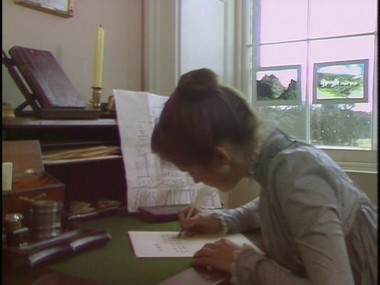
Fanny (Sylvestre Le Tousel) recounting the story through letters: windows, mirrors, candles, chosen at random (‘83 MP)
Ellen
--
Posted by: Ellen
* * *
Comment
- From Marilyn Marshall:
“Ellen, your thoughts on mirror imagery in S&S are fascinating.
In the Keira Knightley version of Pride and Prejudice there is a nighttime scene—a sort of sleepwalking episode—where we view Elizabeth in a mirror in the drawing room and in the background we see Mr. Darcy come through the door and lay his letter on the window sill. I think she breaks her gaze from the mirror to look out the window to see him flying away on horseback. The scene is very dreamlike (Elizabeth is in her nightdress) and obviously not how events would unfold in the normal waking world.
Marilyn”
— Elinor Aug 6, 5:41pm # - From Derrick on Janeites:
“For the male artist or poet the mirror has a significant symbolism in portraying the female form. In Jungian terms, it has something to do with the formation of the muse within the psyche, and its projection onto an external form. Like falling in love, what we see in the beloved is more a reflection of ourselves, and is largely determined by the character of our own ego and its need to change. The visual sense is of primary importance in this process of projection.
There is a symbolic counterpart in the sun and moon, where the moon is visible through reflected light from the sun.
Derrick
ps remember Narcissus!”
— Elinor Aug 6, 5:42pm # - IN response to Marilyn and Derrick,
What I noticed as peculiar and obsessive in the 2005 P&P was the use of narrow corridors in Longbourne. Repeatedly the women and men were photographed against narrow corridors, coming through thresholds, and often in darkened or shadow light. It was a passionae P&P with sympathy for those who couldn’t fit in :) (like Tom Hollander as a nervous uncomfortable Mr Collins).
Derrick’s is a good comment, only the men in these series and in particular the S&S movie are not presented this way. Edward is not looing into the mirror to see his beloved, but to see himself as his society sees him and he is deeply dismayed by that image. He finds it is not himself but he can’t manage to project another as he can’t escape the limited options he’s given. He turns round to see in Elinor’s eyes love, but also (from his point of view) painful compassion. And the woman are not Narcissa, but judging themselves similarly.
While archetypal imagery which likens women to moons and men to suns, is pretty, the implication brings us right back to Milton that women are supposed to swing round men and allow men to guide them and their lives. This is dangerous for women in Austen’s books and men are shown to have their own real problems and blindnesses; in fact Elinor is a stronger person than Edward as Fanny is Edmund and inwardly it may be said Anne is Wentworth (even if the world rewards him with money and not her except through patriarchal inheritance).
Ellen
— Elinor Aug 6, 5:46pm # - From Mary Ann Dimand:
“I just wanted to say thanks for this paricularly brilliant post.
Mary Ann”
To which I replied:
“You’re very welcome. I much appreciate the thank you. The comments by others on the lists mean a lot to me. I actually prefer to write emails and blogs than write long learned papers hardly anyone ever reads :),
Ellen
— Elinor Aug 6, 5:47pm # - Nancy on Janeites wrote:
“I do think JA was writing against some of the ideas of the time such as the superiority of masculine brains and moral fibre, and the innate ability of innocence to recognize evil ,and even that “father knows best.”
However, I do not think JA was subtle about her interests because of fear but because she disliked didactic books and didn’t want to write one. She could have pounded the subjects into the minds of the reading public but chose not to.
The closest we come to a male whose opinion should be respected is Mr. Knightley and even he is affected by jealousy.
Nancy”
— Elinor Aug 7, 8:33am # - Derrick responded:
“Firstly, my comments were not imagery at all, they were symbolic.
Secondly, my comments were addressed to your comments about the portrayal of women in films in mirrors, and not to the portrayal of the male in the mirror. The sun and moon are part of a symbolic language which has long been used poetically to represent parts of the male psyche. Thirdly, if you had not misunderstood my comments they might have led you to ask a really useful question – whether or not the process works in reverse
for the female poet or artist ie do they experience the muse as being male in nature?
As a complete aside, did Jane Austen ever write much poetry?
Derrick”
— Elinor Aug 7, 8:34am # - Sorry to have offended, Derrick. I distrust some of the uses of myth that are made. I have studied a lot of Renaissance erotic sonnets by women; I translated two full sequences (by Vittoria Colonna and Veronica Gambara) and have written for publication about others; this is an area I’m interested in. I’ve written about Katherine Philips’s love poems to women in the 17th century.
http://www.jimandellen.org/vcpoetry/vctitle.htm
http://www.jimandellen.org/vgpoetry/shady.hill.html
Right now I’m reviewing a book on a sonnet sequence by a woman for Renaissance Quarterly.
In general, it does not work in reverse the way you suggest. Rather women in the early sequences are very much obsessed by guilt and shame; their sonnet sequences are about their inner lives as the men’s sonnet sequences are about theirs. The men are not muses; but rather represent trouble and anxiety as well as high sexual encounters of ecstacy. The women most often tell stories of being finally abandoned and shamed. Gaspara Stampa is a third sequence by an Italian renaissance woman which is translated into good English. Mary Wroth is a powerful example of this in English.
In the 19th century and with Elizabeth Barrett Browning you begin to see a change, but I would not say Browning is her muse. They marry so the guilt is gone and women are allowed deep sexual passion. It's really too complicated to discuss here swiftly—it would take the kind of talk we have about Austen to discuss it properly. Christina Rosetti is abject, religious, and writes paeans to death, another type.
Women also write to other women love poetry; men do not (at least not until very recently when it’s no longer a punishable crime); instead they write moving poems of friendship and politics. Women write friendship poems to other women too but these usually combine with retirement motifs and retreat.
Marge Piercy has a book of poetry where she uses the moon imagery as central to women, but she does not use it to make women secondary swirling around the suns of males. She also has a brilliant memoirs, Sleeping with Cats where you find her using the figure (as an emblem) of cats who are really there in the bed with her too—preferable in the end to her first and second husband and various lovers though not her third and last husband.
Austen wrote only a small amount of poetry, but not all of it is comic, some combines comedy and anguish and anger. They have been published.
Ellen
— Elinor Aug 7, 8:36am # - From Elissa:
“All,
Thank you to Ellen for her extremely cogently written and enlightening [no pun intended] analysis of women’s sonnets and poetry sequences, especially the tracing of metaphorical uses of moon/sun imagery.
Women’s Italian and French Renaissance poetry is a fascinating and still largely unexplored treasure field of riches that explore the female psyche. Austen’s novels really are her prosedy. I think they are very close in mood and sentiment to the poems of her slightly later American contemporary [and sister artist in the publication wars], Emily Dickinson.
One point though – and here I must disagree with Ellen, whose knowledge of the history of European women’s poetry is extraordinary: Wentworth, to me, seems quite strong psychically; he’s weathered many a real [at sea] and emotional storm after having been deeply hurt by rejection; he has become a highly respected captain and leader of men; perhaps he just takes a bit longer than Anne to heal his wounded pride, but he is a forceful man like Darcy and totally unlike Edward Ferrars or Edmund Bertram.
Elissa”
— Elinor Aug 7, 5:31pm # - From Fran:
“I imagine the Bollywood books you’ve cited recently went into the influence of Hollywood’s old song and dance films and melodramas on Mumbai’s film production, but do they also go into the present, marked cross-influence of Bollywood on western films in return? Quite a few romantic comedies I’ve seen out on DVD recently use Bollywood elements, for example, though not always terribly successfully.”
— Elinor Aug 12, 3:07pm # - On the books on Bollywood, Fran, yes, at least Chavarkavty does
suggest how Hollywood movies are influenced by Bollywood ones; true,
only in passing as it’s not her topic to be fair; she wants us to pay respectful attention to Bollywood. Both she and Mishra begin with general discussions of movies as such and much they say goes first for all popular and art movies. Mishra too suggests Hollywood does what Bollywood does but this is probably me reading into the text what is not made explicit there.
Ellen
— Elinor Aug 12, 3:09pm #
commenting closed for this article
